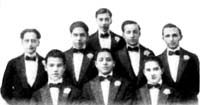Imperial Marimba Band
The Blue and White Marimba Band, latest Columbia Artists, have been the elect musical sensation of New York’s social season. Besides appearing all winter in the Hippodrome, these musicians have played in the private homes of practically the Blue List of New York’s “400”. Their musical gifts are now offered [to] the public through their first Columbia recordings.
The performance of the Blue and White Marimba Band of Guatemala at New York City’s Hippodrome in 1916 was the spark that ignited America’s new interest in the music of Guatemalan Marimba Bands. That concert quickly led to recordings by the group for both Columbia and Victor. Performances by the Cardenas Marimba Band and the Royal Marimba Band appeared on the Columbia label. The latter group featured another great mallet player, Celso Hurtado, who also recorded for Victor with the Hurtado Brothers Royal Marimba Band. Soon excellent ensembles from Guatemalan and Mexican were touring America, performing at expositions and in vaudeville theatres. By 1919, the popularity of these groups and their recordings had begun to wane.
 Imperial Marimba Band
Imperial Marimba Band Marimba Centro-Americana
Marimba Centro-Americana
In 1917, the Edison Company issued their first four-minute Blue Amberol cylinder marimba recording, A Garden Dance (#3557), performed by an ensemble calling itself Imperial Marimba Band. They quickly released an Edison disc recording of Blue Danube Waltz and The Messenger Boy March (#50413). The marimbas on these recordings have the buzzing sound that is typical of Guatemalan marimbas, although later performances of the “Imperial Marimba Band” on the Edison label were apparently recorded by a different ensemble containing a piano, saxophone, xylophone, and a marimba without the buzzing membranes.
While the personnel of the Imperial Marimba Band is uncertain, the earliest recordings were probably made by musicians from Mexico or Guatemala. William Cahn thinks it is likely that later recordings by the ensemble calling itself the Imperial Marimba Band probably included George Hamilton Green, Joseph Green, and possibly William Dorn and Harry A. Yerkes.
The Gerhardt Collection includes eight Edison Blue Amberol cylinder recordings by the Imperial Marimba Band, including recordings from 1917 of Blue Danube Waltz (#3136) and The Messenger Boy March (#3104) that had also been sold in disc format. William Cahn reminds us that, when the Edison Company began to produce discs in 1912, the same recording sessions were frequently used to simultaneously make both the Edison Diamond Discs and the Edison Blue Amberol cylinders.
This information is taken from William Cahn, The Xylophone in Acoustic Recordings (1877 to 1929) Bloomfield, NY: Cahn Publishing, 1996.








